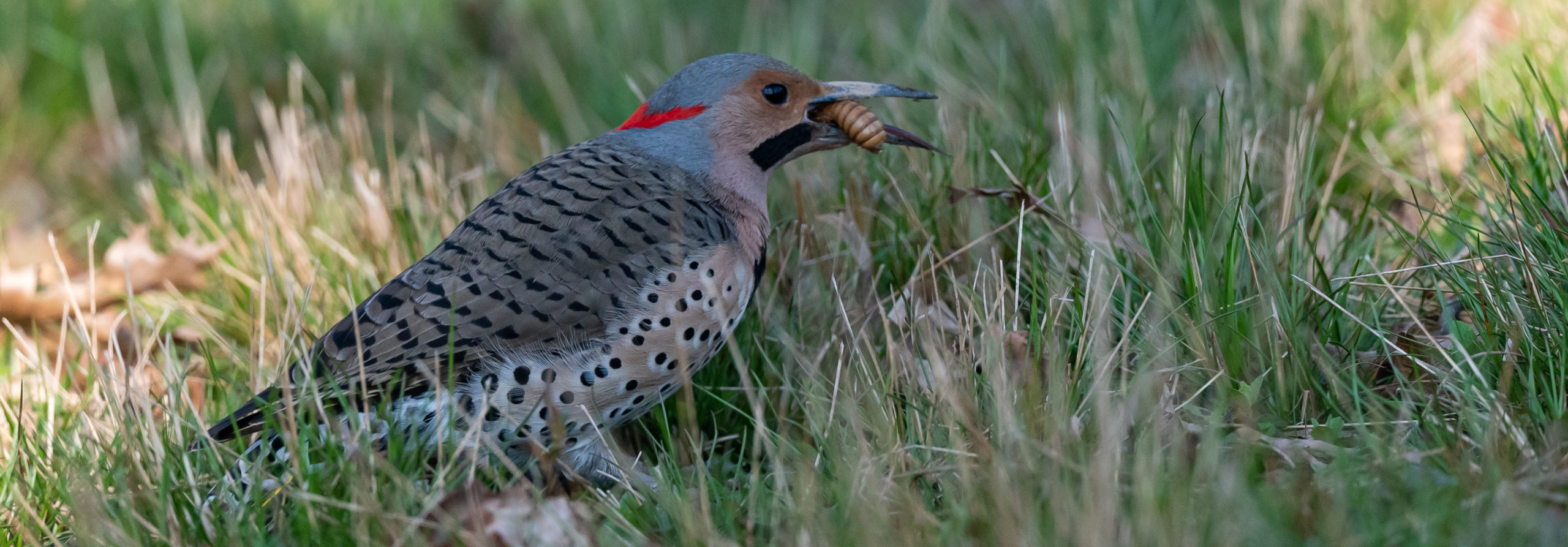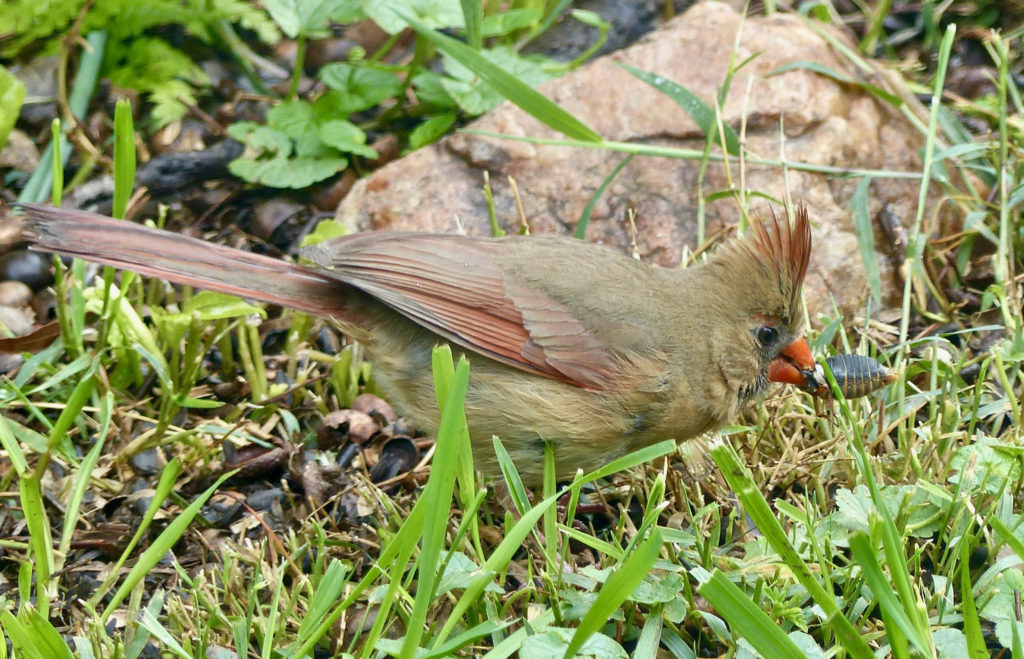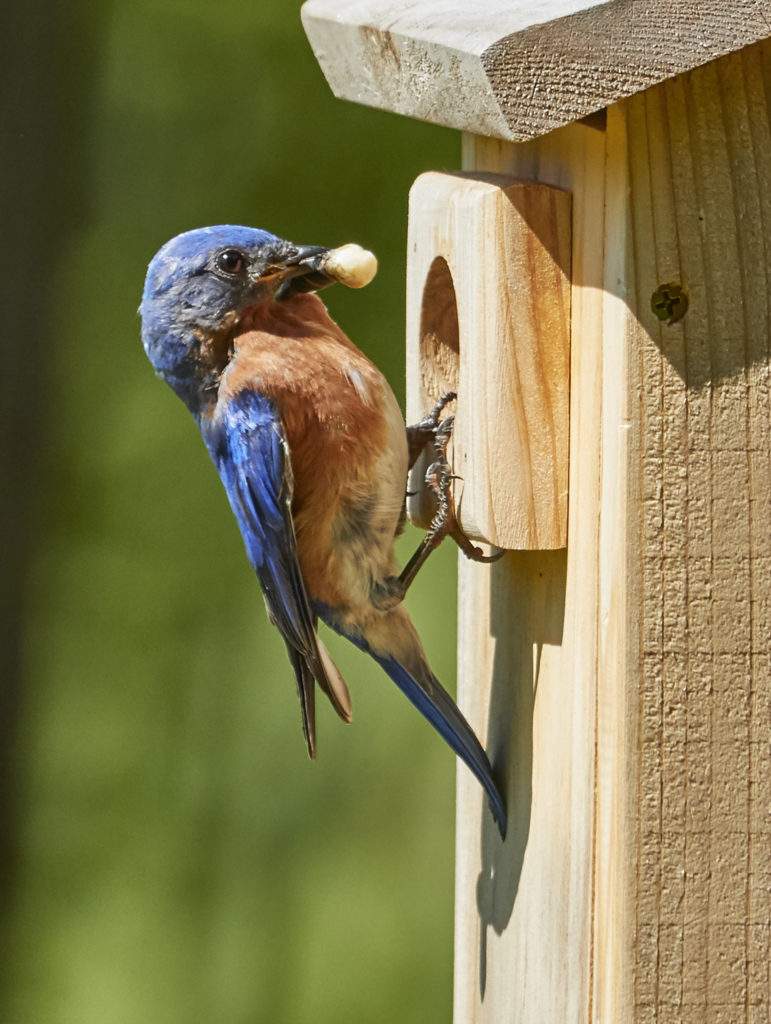 Photo ©
Bonnie Ott
Photo ©
Bonnie Ott
by Robyn Bailey, NestWatch Project Leader
Have you heard the buzz? This spring is a once-every-17-years opportunity for birds to binge on periodical cicadas. This year’s brood, known as Brood X, is touted as being one of the largest of the 17-year cicada broods, with densities estimated to reach more than one million cicadas per acre. These insects spend 99.5% of their lives underground feeding on nutrients sucked from tree roots in the eastern United States. The last time a Brood X cicada saw the light of day was 2004—three years before the first iPhone was introduced.

Big Beaks For Big Bugs
A female Northern Cardinal eats a cicada.
NestWatcher Chrisula Stone wrote to ask our staff if we had any expectations about how Brood X might impact nesting birds. The scientific literature tells us that some species do respond to this immense pulse of food that happens in 13-year and 17-year intervals, the effects of which can last a few generations. According to one study (Koenig and Liebhold 2005), Black-billed and Yellow-billed Cuckoos, Red-bellied Woodpeckers, Blue Jays, Common Grackles, Brown-headed Cowbirds, Red-headed Woodpeckers, American Crows, Tufted Titmice, Gray Catbirds, and Brown Thrashers increased in number either during or immediately following cicada emergence years. This study looked at large-scale citizen-science data that tracked numbers of birds, but the authors were not able to determine the mechanism for how the 13-year and 17-year cicadas increased the populations of their avian predators. For that, we turned to another study which investigated the effects of the 13-year Brood XXI on Red-winged Blackbird nesting success in 1976 (Strehl and White 1986). These authors found that nestling weight and fledging rate (but not clutch size) increased in the year of cicada emergence when compared to the previous and subsequent year.
It Could Be A Banner Year
Mike Watson, NestWatch Chapter Coordinator for Holden Arboretum, has previously written about the positive impacts of Brood V in 2016 on Eastern Bluebirds in Holden Arboretum. Mike offers a few hypotheses for how the cicadas could have led to a 26% increase in number of fledglings over the previous “best year on record.” One thought is that the females could lay more eggs in response to more food; this would primarily benefit second or third clutches, which tend to be smaller than first clutches. More birds could wrap up the first brood in better condition, and therefore, more might attempt a second and third clutch. Another idea is that with food lying everywhere, the adults do not have to search far for food and could spend more time at the nest, incubating eggs and defending against predators. Additionally, it is possible that if cicadas are fed to nestlings directly, the nestlings could be more likely to fledge. According to Mike’s analysis, more eggs were laid, more second and third broods were attempted, and hatching success was improved, but he did not find much support for an increase in fledging rate. This suggests that the primary benefits are experienced by adult bluebirds who endure the season in better condition, rather than benefiting nestlings as a major food source.

An Abundance of Food
This male Eastern Bluebird spent all day catching these 17-year cicadas on the ground and tearing off the soft abdomen part. He made many trips to the nest box with these little morsels.
With long-term data from NestWatch, scientists could investigate this effect across the breeding range of the Eastern Bluebird and other common species known to prey on cicadas. Those living outside of the core emergence area of Brood X can also contribute nesting data as “controls” against which to compare. We encourage you to submit your nesting data this year, along with any photos or videos showing birds eating cicadas (note that there are also species of cicadas which emerge every year in smaller numbers). If you’re insect-inclined, you can also submit observations of periodical cicadas to the citizen-science effort Cicada Safari.
References:
- Koenig, W. D., and A. M. Liebhold. 2005. Effects of periodical cicada emergences on abundance and synchrony of avian populations. Ecology 86(7):1873–1882.
- Strehl, C. E., and J. White. 1986. Effects of superabundant food on breeding success and behavior of the Red-winged Blackbird. Oecologia 70(2):178–186.
I heard that 17-year cicada life cycle evolved with passenger pigeon life cycle. Is that true?
Hi Nancy, I’ve not heard of this theory, but so far it seems that it is not known exactly why periodical cicadas emerge every 13 or 17 years. Some have postulated that these numbers – 13 and 17 – are prime numbers, and therefore it would be extremely hard for a predator to evolve to depredate these insects specifically. Here is an article that can provide more information and has resources to explore this further.